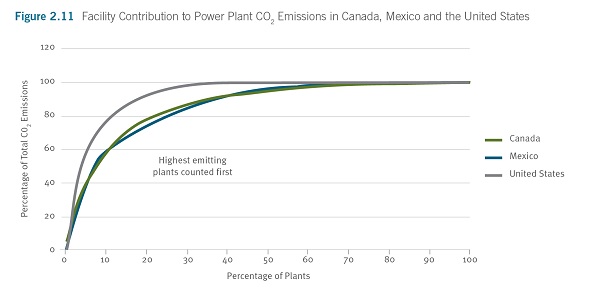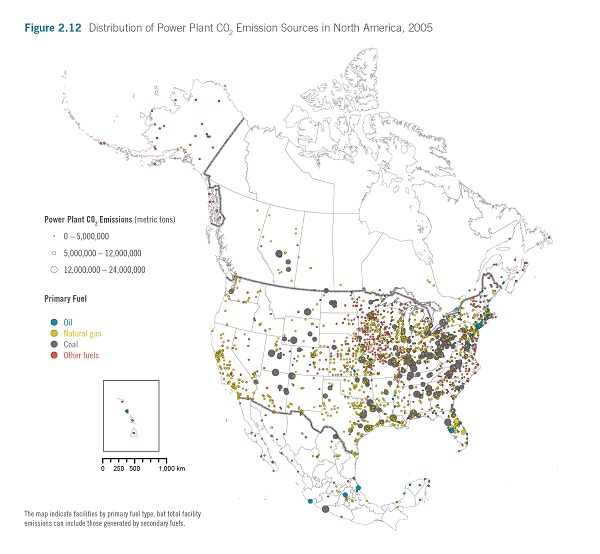Greenhouse Gases (GHG)
Emissions of GHG from fossil fuel-based electricity generation are available for CH4, and N2O along with other parameters such as electricity generation, emission factors and fuel type. For this report, only emissions of CO2, CH4 and N2O are taken into account, as these are the main greenhouse gases released by fossil fuel-based power plants (see Section 3.3.5).
As mentioned in the discussion on climate change in Section 2.1, CO2 is by far the largest GHG emitted by the electricity generation sector in North America. Table 2.22 summarizes GHG emissions from power stations in the three countries, with emissions of CO2 accounting for over 99% of total power plant GHG emissions in each country. In terms of equivalent tonnes of CO2, the emissions of N2O represent less than 0.5% of the total, with emissions of CH4 being even less.
Table 2.22. Total Emissions and Emission Rates of Major GHGs from Power Stations in North America, 2005

In Canada, 72 of the 189 power plants reported emissions of CO2 to the GHGRP; 14 of these facilities did not report emissions of CH4 or N2O. The total emissions of GHGs from those 72 plants in units of CO2-eq were 122 million tonnes. Considering a total estimated generation of 133,764 GW-h from those 72 plants, the national average emission rate was 0.92 t of CO2-eq/MW-h (or 920 kg/MW-h). CO2 emissions accounted for 99.1% (121,299,282 t.) of the total reported by Canadian power plants for 2005, while CH4 emissions equaled 2,465 t and N2O emissions were 3,501 t. Thus, in terms of both emissions and global warming potential, CO2 was the most important greenhouse gas emitted by these facilities.
Emissions of CO2 are strongly dependent on the type of fuel used. Sub-bituminous coals, for instance, have emission factors in the order of 0.1 kg/MJ, residual fuel oils (No. 6) have emission factors in the order of 0.07kg/MJ, and natural gas has an emission factor in the order of 0.05 kg/MJ (i.e., about half that of coal).
Although there are other factors involved in the plant emission rate of CO2 from different types of fuel, it can generally be said that coal results in more emissions than oil, and oil in more emissions than natural gas.
The ten largest CO2 emitters were all coal-based, and accounted for about 69% of total CO2 emissions reported by Canadian power plants for 2005. Because of the way the generated power was estimated for Canada, the amount of CO2 emissions was fairly proportional to the power generated.
However, it is important to remember that the data on emissions of GHGs represent just over one-third of all Canadian power plants included in this report. Detailed data on CH4 and N2O emissions for the 58 reporting facilities are available online at www2.cec.org/site/PPE/emissions.
In Mexico, total GHG emissions from the 102 power plants considered were 118 million tonnes of CO2-eq. Emissions of CO2 were 117,737,070 t (or 99.5% of the total), with CH4 emissions totaling 2,569 t and N2O emissions, 1,745 t. Detailed data for emissions of CH4 and N2O from Mexican power plants are provided online.
In Mexico there are only three coal-fired power plants, thus within the ten largest CO2 emitters, most oil-fired power stations. The ten largest CO2 emitters accounted for about 57% of the total CO2 emissions. The national average GHG emission rate was estimated to be 0.6538 t/MW-h (or 653.8 kg/MW-h).
In the United States, all 2,728 power plants included in this report emitted a total of 2,431 million tonnes of CO2-eq of GHG, with 2,718 of them having data for emissions of CH4 and N2O. The US facilities' average GHG emission rate was estimated to be 0.82 t/MW-h (or 820 kg/MW-h), which is lower than both the Canadian and Mexican rates.
The large disparity in the total electricity production among the three countries is apparent from the comparison of the amounts of CO2 emitted. CO2 emissions from US power plants were 2,419,514,935 t (or 99.5% of total GHG emissions), while emissions of CH4 were 33,590 t and emissions of N2O were 35,428 t. The sixteen largest emitters of CO2 in the United States released over 280 million tonnes of CO2, which is more than the combined CO2 emissions from power plants in Mexico and Canada.
Regarding the CO2 emission rate by fuel type, for coal the value is 0.94 t/MW-h (or 940 kg/MW-h), for oil it is 0.74 t/MW-h (740 kg/MW-h), and for natural gas, 0.42 t/MW-h (420 kg/MW-h). In terms of the number of power stations emitting CO2, natural gas was the predominant fuel used by 50% of the US power stations (with 27% and 22% of the plants burning oil and coal, respectively).
However, in terms of electricity generation, coal was used to produce 71% of the total electricity from fossil fuels, followed by natural gas with 25%, and heavy fuel oil with 3.6%. Thus, heavy fuel oil appears as a minor source of CO2, as compared to coal, natural gas and other fuels.
Table 2.25 shows that the top ten US power plants, ranked by emissions of CO2, accounted for 8% of all CO2 emissions by US power plants in 2005.

Figure 2.11 shows the CO2 emissions contribution of all the plants in North America for which data were available, from the largest to the smallest emitters. It can be seen that 20% of the total number of plants in the United States accounted for roughly 90% of the total CO2 emissions.
For Mexico and Canada, 35% of each country's power plants accounted for 90% of their respective total CO2 emissions (but readers are reminded that data for CO2 emissions were available for just over one-third of the Canadian power plants included in this report).
As mentioned before, CO2 emissions are to a large extent proportional to the electricity generated; power plants with the largest generation are also the major emitters of CO2.
For Canada, some emission rates were calculated based on an estimated electricity generation and should be regarded with some reservation. In the case of the United States, more than 92% of the power stations had a CO2 emission rate in the range of 200 to 1500 kg/MW-h, while for Mexico about 80% of the power stations were in this range, irrespective of the technology or type of fuel used.
A closer examination is needed of the plants with emission rates above this range, with possible reasons being that the data are biased, there were unusual operating episodes, or the power plants were highly inefficient.
The geographical distribution of the CO2 sources for 2005 is shown in Figure 2.12. The size of the dots represents the magnitude of emissions and the color represents the type of primary fuel used.
The two most important CO2 emitters in Canada were located in the provinces of Ontario and Alberta and were both coal-fired power plants. In contrast, Mexico shows a more uniform distribution across the country, with one isolated spot of very large emissions in Guerrero, on the Pacific Ocean coast.
Consistent with the geographical distribution of sources of other pollutants mentioned in this report, there was a very large number of power plants emitting CO2 in the eastern half of the United States, and also significant concentrations in California (259 plants) and Texas (191 plants). Some coal-fired power stations with large emissions can also be seen in the Midwest states.


